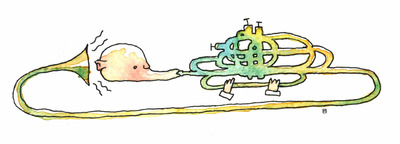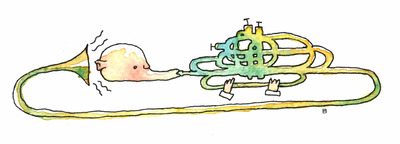As I mentioned in my previous article, How to Approach Ear Training, my current approach to practicing ear training is modeled around my same approach to practicing my instrument. Whatever your instrument is, you know the importance of a warm-up routine. Besides the obvious intention of getting “warmed-up,” as in a mental and physical preparation for playing, one of the great advantages of a well-structured routine is the application of fundamentals.
For example, my primary instrument is the trombone and I have focused my warm-up routine on fundamentals of brass playing. The idea here is to get as much out of these ear training exercises that I can and, furthermore, to choose exercises that will benefit multiple aspects of my playing. When I go to practice the trombone, I start by playing on just the mouthpiece, without the rest of the instrument and all the extra stuff it requires me to think about. Besides being an excellent way of getting all the facial muscles involved with playing warmed-up and ready to play, it’s also probably the most vital exercise for tone control, tone quality, flexibility and range. It’s a chance to focus on the very basics of brass playing. I could go on through my other warm-up exercises, but you get the idea. This same tactic, though, can be applied to ear training.

Practise listening to long notes to warm up your ears
The focus of a warm-up routine in ear training is nearly the exact same as with an instrument. While there’s really no physical preparation for ear training, there certainly is a mental preparation that is necessary. It’s also a great time to work on fundamentals—wide-ranging exercises that benefit multiple aspects of ear training.
Warm-Up 1: ‘Long notes’
The first step is a mental preparation, an act of focusing on the task at hand. I like to do this by means of “long tones.” If you’re a wind instrument player, you know the importance of long tones in that regard. If not, long tones are basically a way of easing into playing. You don’t do a strenuous exercise routine without stretching your muscles. Likewise, wind players don’t play without warming up through long tones. This works a similar way in ear training. I always do my ear training exercises at the piano, so I’ll describe them in that way. I start by simply playing random notes in the middle of the keyboard, between about C below the bass clef to about C above the treble, without looking at the notes I’m playing. Then, I just listen. I play the note at about a mezzo-forte or forte, and, holding the key down, let it die away naturally. I listen to the note until I can’t hear it anymore. In my experience, this simply makes you slow down, since the middle notes of a piano has a good amount of sustain, and focus your ear and mind on the task at hand.
This is simply a warm-up exercise. If you want to turn it into a fundamental exercise, you name the note you just listened to. You’re very possibly going to miss the first note you play, but after that, you’ve got a reference point to work from. Once you’ve got that reference point, you listen for the interval each note forms with the previous one and then use that to name the pitch. Now, you’re both warming up and practicing intervals in a fundamental way that will be a great advantage to you in more advanced ear training exercises. This exercise can take some time, mostly just because of the time it takes the notes to decay. Five to ten minutes of this exercise is good to start off with because it gives you a fair amount of time to listen to different notes.
Warm-Up 2: Singing Intervals
Another important fundamental exercise you can do is singing intervals, and this is an exercise that will help you beyond ear training. In this exercise, you’re going to play an interval and then sing the individual pitches, starting with the lowest. When you start out with this exercise, it’s best to begin with easy intervals like thirds and sixths, and to leave difficult intervals like seconds and sevenths till later. It’s also best to stick to just the white keys of the piano in the beginning. Later, you can add in the black keys as well. To play a third, simply play any two white keys on the piano with another white key in between. For a sixth, play any two white keys with four white keys in between. The first thing you will probably notice is how difficult it is to focus on that lowest note of an interval and to sing it. For some reason we tend to zero-in on that top note and it takes a little practice to break that habit.
When I started doing this exercise on a routine basis, I noticed two things. First, I was able to pick out and hear the inner parts of a piece of music much better than I could before. This will no doubt be beneficial when you’re doing harmonic dictation, as the inner voices are difficult to hear. The second thing was an unexpected bonus. I noticed that my intonation when playing the trombone improved. In singing intervals, you’re not only internalizing the distinctive sound of an interval, but you’re also becoming more sensitive to intonation.
Find Your Own Warm-Up Routine
These two exercises form the bulk of my warm-up. I do a few minutes of each before getting into any advanced exercises. With the intervals, I cycle through them. One day I’ll do thirds, the next sixths, and so on. This is my warm-up and fundamentals routine, and you can use it to get started. However, like it is with your instrument, it’s important to develop your own personal routine, and this requires a little bit of creativity. The point is to figure out what works best for you. This also goes back to my previous article about knowing how to critique your own work. A warm-up routine isn’t a static thing that you never change. There are some parts of it that remain constant, but you also adjust it to focus on things that you are currently struggling with. So, start with something basic and then experiment. Here are a couple of ideas to get you started:
- Start with a note, say, middle C. Play that note and then three or four random notes after it, without looking, at about a quarter note = 60 (one second per note). Then try to name the intervals and notes. This will help with melodic dictation.
- Play entire chords and try to sing each note of the chord. For example, play an F major chord, and try to sing the notes from the lowest to the highest. If you’re feeling really brave, you can even do seventh chords, and so on.
Taking the time to warm up before a session of ear training can really make the difference to how much you achieve. Make sure you try the suggestions above, and if you come across any techniques you find particularly helpful, let us know in the comments below.
See also: How to approach ear training







